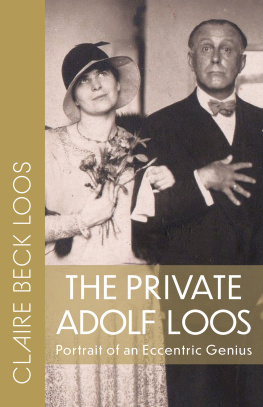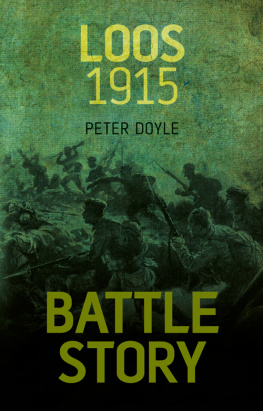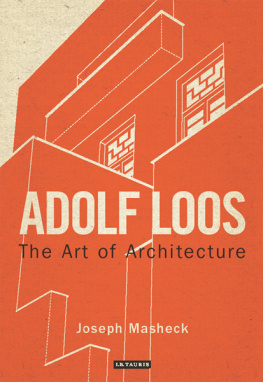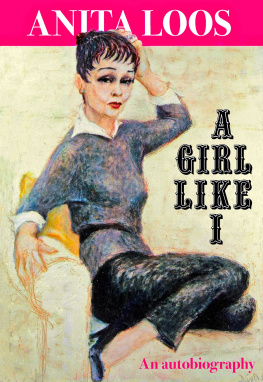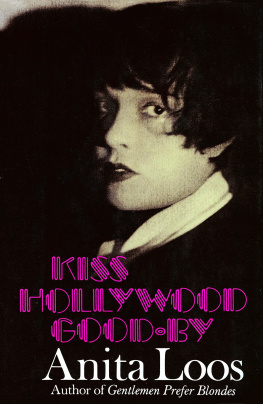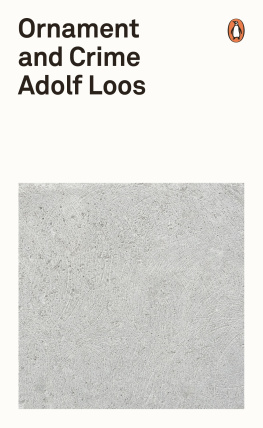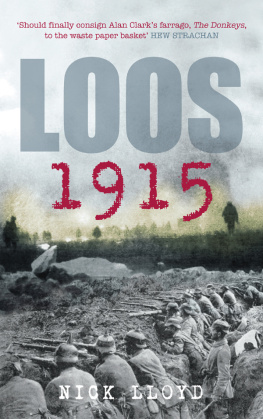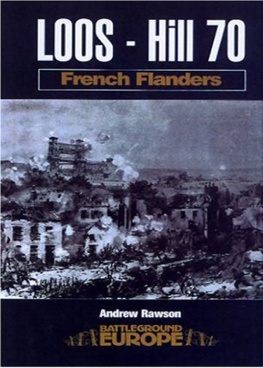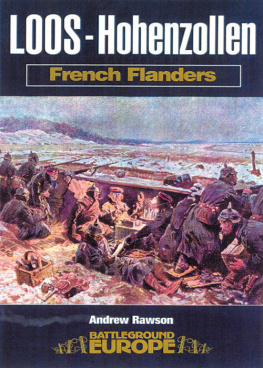Claire Beck Loos - The Private Adolf Loos: Portrait of an Eccentric Genius
Here you can read online Claire Beck Loos - The Private Adolf Loos: Portrait of an Eccentric Genius full text of the book (entire story) in english for free. Download pdf and epub, get meaning, cover and reviews about this ebook. year: 2020, publisher: DoppelHouse Press, genre: Detective and thriller. Description of the work, (preface) as well as reviews are available. Best literature library LitArk.com created for fans of good reading and offers a wide selection of genres:
Romance novel
Science fiction
Adventure
Detective
Science
History
Home and family
Prose
Art
Politics
Computer
Non-fiction
Religion
Business
Children
Humor
Choose a favorite category and find really read worthwhile books. Enjoy immersion in the world of imagination, feel the emotions of the characters or learn something new for yourself, make an fascinating discovery.
- Book:The Private Adolf Loos: Portrait of an Eccentric Genius
- Author:
- Publisher:DoppelHouse Press
- Genre:
- Year:2020
- Rating:4 / 5
- Favourites:Add to favourites
- Your mark:
- 80
- 1
- 2
- 3
- 4
- 5
The Private Adolf Loos: Portrait of an Eccentric Genius: summary, description and annotation
We offer to read an annotation, description, summary or preface (depends on what the author of the book "The Private Adolf Loos: Portrait of an Eccentric Genius" wrote himself). If you haven't found the necessary information about the book — write in the comments, we will try to find it.
The Private Adolf Loos: Portrait of an Eccentric Genius — read online for free the complete book (whole text) full work
Below is the text of the book, divided by pages. System saving the place of the last page read, allows you to conveniently read the book "The Private Adolf Loos: Portrait of an Eccentric Genius" online for free, without having to search again every time where you left off. Put a bookmark, and you can go to the page where you finished reading at any time.
Font size:
Interval:
Bookmark:

THE PRIVATE ADOLF LOOS
The Private Adolf Loos
Claire Beck Loos
Translated by
Constance C. Pontasch
Nicholas Saunders
Carrie Paterson Editor
DoppelHouse Press | Los Angeles
The Private Adolf Loos: Portrait of an Eccentric Genius
By Claire Beck Loos
Translated by Constance C. Pontasch and Nicholas Saunders
Edited by Carrie Paterson
DoppelHouse Press, 2020 All rights reserved.
Adolf Loos Privat by Claire Beck Loos
Johannes-Presse, Vienna, Austria
1936 Claire Beck Loos
Book design: Carrie Paterson
Cover design: Carrie Paterson and Janet L
Publishers Cataloging-in-Publication data
Names: Loos, Claire, author. | Pontasch, Constance C., translator. | Saunders, Nicholas, translator. | Paterson, Carrie, 1972-, editor.
Title: The Private Adolf Loos : portrait of an eccentric genius / by Claire Beck Loos ; translated by Constance C. Pontasch and Nicholas Saunders ; Carrie Paterson, editor.
Description: Los Angeles, CA : DoppelHouse Press, 2020.
Identifers: LCCN: 2020931079 | ISBN: 9780997003482 | 9781733957939 (ebook)
Subjects: LCSH Loos, Adolf, 1870-1933. | Loos, Claire. | Architects--Austria--Biography. | Architects--Czechoslovakia--Biography. | Architects--Europe--Biography. | Architecture--Austria--Vienna--History--20th century. | Architecture--Czech republic--History--20th century. | Vila Mller (Prague, Czech Republic) | Jewish authors--Biography. | Jewish women--Biography. | Photographers--Czechoslovakia--Biography. | BISAC BIOGRAPHY & AUTOBIOGRAPHY / Artists, Architects, Photographers | BIOGRAPHY & AUTOBIOGRAPHY / Historical
Classification: LCC NA1038.L6 L62 2020 | DDC 720/.92/4--dc23

Dedicated to Charles Paterson in memorium
CONTENTS
by Claire Beck Loos
PREFACE REFLECTIONS OF A FEMALE PROTG
An inscription by the author on a found second-hand copy of her 1936 book, Adolf Loos Privat [The Private Adolf Loos], is revealing: In memory of a feverish time. Claire Beck Loos.
What follows is Claires documentation of this passionate moment in culture, as well as her short-lived but impactful marriage to one of the great minds of the early-twentieth century. Through a penetrating view of her ex-husband, the architect Adolf Loos, she offers a dramatic and personal understanding of what it is to have spent time with a genius, an older mentor, and retain some of the creative psychic residue impressed by that experience.
Claire comes away from her time with Loos a changed person, and like anyone who has thrown himself or herself with abandon into a new mode of thinking in rebellion or out of necessity her struggle to integrate this moment into her life requires a generative act: this book. Through the unique form of her writing we learn not only about Loos and his work, but also about the role of emotional connections in forging new times.
CARRIE PATERSON, EDITOR

Adolf Loos in the living room of his apartment in Vienna, Giselastrasse 3, now Bsendorferstrae, Vienna I, 1929.
Courtesy Janet Beck Wilson
PHOTO CLAIRE BECK
ADOLF LOOS
A SHORT BIOGRAPHY
Adolf Loos (December 10, 1870 August 23, 1933) was born in Brunn (Brno, Czech Republic), the Moravian edge of Austro-Hungary. Son of a stonemason and sculptor, Loos studied architecture in Dresden from 18901893. He lived in the United States for three years following his education and then moved to Vienna to practice architecture in 1896. Within Viennas lively fin-de-sicle caf culture he began to formulate ideas on cultural reform and urban development, beginning what was virtually a second career as a writer and lecturer. He published articles in Die Zeit, Die Wage, and the Neue Freie Presse, but also briefly put out his own publication, Das Andere [The Other], which was a journal promoting the introduction of Western Civilization into Austria. Loos writings were later collected in several volumes, including Ins Leere Gesprochen [Spoken into the Void] in 1921, and Trotzdem [Nevertheless] in 1931; a portion have been translated into English as Ornament and Crime, Selected Essays (Ariadne Press, 1998), some of which are reprinted at the end of this volume.
In addition to his written work, Loos gave some sixty lectures from 1910 onward to audiences in Vienna, Prague, Brno, Berlin, Paris, Graz, and Munich.
Loos was influenced both by the Greek architect Vetruvius and Anglophone culture, and he incorporated aspects of classical architecture into his early work. Of these, a notable design was for the Chicago Tribune Tower (1922, unbuilt), a skyscraper in the form of a Greek column. Loos use of iconography was short-lived, as he turned his attention to revolutionizing building practices, valorizing the craftsman and the laborer, opposing the wasteful ornamentation of the Viennese Secession and objecting loudly to mixing art and craft (epitomized by the work of his archenemies Koloman Moser and Josef Hoffmann at the Wiener Werksttte), as well as pioneering the use of raw materials for their simplicity and beauty.
Loos most radical project in Vienna, his Goldman & Salatsch building (19091911) on the Michaelerplatz, became colloquially known as the building without eyebrows. Its defining distinction is a complete lack of ornamentation on the facade, which reputedly so offended Emperor Franz Josef that he refused to exit the Hofburg Palace on the side facing the Loos Haus. Among Viennas other Loosian attractions are the Caf Museum (1899), The American Bar (or Krntnerbar, 1907), Knie Mens Outfitters (19091913) and his contribution to the Werkbundsiedlung housing project, a duplex (19311932).
During his lifetime Loos designed, built, and remodeled close to one hundred apartments and homes, and undertook a number of large civic projects like schools, government buildings, and workers housing. Dozens of additional works included sanatoriums, hotels, cafs and bars, and shops. Several of Loos projects were not realized but still remain influential, like the black-and-white striped marble house for Josephine Baker (1928) with its dramatic lighting and view underwater into the swimming pool.
Most relevant to this book, with its domestic and intimate qualities, are Loos striking interiors. Using marble and wood veneers, beautiful hardwoods, brightly colored paints, glass block, mirror, photo murals, and even fur (for the bedroom of his first wife, Lina Loos), he transformed and sensualized the experience of space. His revolutionary open floor plans and stepped half-floors, sometimes conceived in a caf and drawn on a napkin, created cubic arrangements; this intuitive method, coined the Raumplan by one of his students, came to full expression during the time period of Claires narrative. Considered one of his most important contributions to Modern architecture, the Villa Mller (192830) in Prague, now a museum, is an excellent example of his highly evolved architectural philosophy.
But his work was neither immediately accepted nor appreciated, and Loos expressed constantly his feeling that he was either ignored or not properly recognized. As noted architecture historian Otto Kapfinger writes in his Afterword to the 2007 German edition of Adolf Loos Privat,
Loos was one of the most important reformers, innovators, and architectural critics of the 20th century. Internationally, the amount of literature written about his lifes work has increased tremendously in recent decades. During the course of his lifetime, Loos efforts in the area of architectural and practical design for everyday application through which he strove to free humanity from superfluous labor generally garnered him more ridicule and misunderstanding than anything else. Only a very few, like-minded people were able, or even wanted to accept this cultural reformer an extremely exacting destroyer of clutter, where ideals and materials were concerned.
Next pageFont size:
Interval:
Bookmark:
Similar books «The Private Adolf Loos: Portrait of an Eccentric Genius»
Look at similar books to The Private Adolf Loos: Portrait of an Eccentric Genius. We have selected literature similar in name and meaning in the hope of providing readers with more options to find new, interesting, not yet read works.
Discussion, reviews of the book The Private Adolf Loos: Portrait of an Eccentric Genius and just readers' own opinions. Leave your comments, write what you think about the work, its meaning or the main characters. Specify what exactly you liked and what you didn't like, and why you think so.

